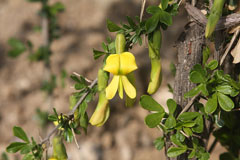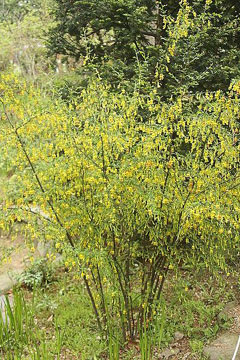 |
|
http://commons.wikimedia.org/wiki/User:Dalgial |
 |
| http://commons.wikimedia.org/wiki/User:Dalgial |
Translate this page:
Summary
Physical Characteristics

 Caragana sinica is a deciduous Shrub growing to 1.5 m (5ft).
Caragana sinica is a deciduous Shrub growing to 1.5 m (5ft).
See above for USDA hardiness. It is hardy to UK zone 6. It is in flower from May to June, and the seeds ripen in September. The species is hermaphrodite (has both male and female organs) and is pollinated by Bees.
It can fix Nitrogen.
It is noted for attracting wildlife.
Suitable for: light (sandy) and medium (loamy) soils, prefers well-drained soil and can grow in nutritionally poor soil. Suitable pH: mildly acid, neutral and basic (mildly alkaline) soils. It cannot grow in the shade. It prefers dry or moist soil and can tolerate drought. The plant can tolerates strong winds but not maritime exposure.
UK Hardiness Map
US Hardiness Map
Synonyms
C. chamlagu. Lam. Robinia sinica.
Plant Habitats
Woodland Garden Sunny Edge;
Edible Uses
Edible Parts: Flowers
Edible Uses:
Flowers - raw or cooked[46, 61, 105, 177]. Boiled and washed[179].
References More on Edible Uses
Medicinal Uses
Plants For A Future can not take any responsibility for any adverse effects from the use of plants. Always seek advice from a professional before using a plant medicinally.
Antiinflammatory Restorative Tonic VD
The root contains a number of medically active constituents including saponins, stilbenes and caraganosides[279]. It has been shown to have antiinflammatory activity and is used in Korea in the treatment of arthritis, neuralgia, diarrhoea and bone weakness[279]. It is said to be restorative and tonic[74]. The stem is made into a broth with other foods and used in the treatment of advanced syphilis[218].
References More on Medicinal Uses
The Bookshop: Edible Plant Books
Our Latest books on Perennial Plants For Food Forests and Permaculture Gardens in paperback or digital formats.

Edible Tropical Plants
Food Forest Plants for Hotter Conditions: 250+ Plants For Tropical Food Forests & Permaculture Gardens.
More

Edible Temperate Plants
Plants for Your Food Forest: 500 Plants for Temperate Food Forests & Permaculture Gardens.
More

More Books
PFAF have eight books available in paperback and digital formats. Browse the shop for more information.
Shop Now
Other Uses
References More on Other Uses
Cultivation details
Prefers full sun and a light sandy dry or well-drained soil[1, 11, 200]. Does not require a rich soil, succeeding on marginal land[11]. This species prefers a continental climate with hot summers and cold winters, it does not grow so well in mild maritime areas such as western Britain. The bark smells like liquorice[182]. This plant is closely related to C. ussuriensis. (Rel.)Pojark. (with which it was once united), a low shrub of rocks, forest glades and roadsides[74]. Plants in this genus are notably resistant to honey fungus[200]. This species has a symbiotic relationship with certain soil bacteria, these bacteria form nodules on the roots and fix atmospheric nitrogen. Some of this nitrogen is utilized by the growing plant but some can also be used by other plants growing nearby[200].
References Carbon Farming Information and Carbon Sequestration Information
Temperature Converter
Type a value in the Celsius field to convert the value to Fahrenheit:
Fahrenheit:
The PFAF Bookshop
Plants For A Future have a number of books available in paperback and digital form. Book titles include Edible Plants, Edible Perennials, Edible Trees,Edible Shrubs, Woodland Gardening, and Temperate Food Forest Plants. Our new book is Food Forest Plants For Hotter Conditions (Tropical and Sub-Tropical).
Shop Now
Plant Propagation
Seed - best sown as soon as it is ripe in a cold frame[200]. It usually germinates in 2 weeks[K]. Stored seed should be pre-soaked for 24 hours in warm water then sown in a cold frame[78, 113, 200]. If the seed has not swollen then scarify it and re-soak for another 12 hours before sowing[138]. Germination usually takes place within 2 - 3 weeks at 20°c[138]. Good percentage[11]. As soon as they are large enough to handle, prick the seedlings out into individual pots and grow them on in a greenhouse for at least their first winter. Plant them out into their permanent positions in late spring or early summer, after the last expected frosts. Cuttings of half-ripe wood, 7 - 10cm with a heel, July/August in a frame[113]. Layering in spring.
Other Names
If available other names are mentioned here
Native Range
TEMPERATE ASIA: China (Fujian Sheng, Guangxi Zhuangzu Zizhiqu (north), Guizhou Sheng, Hebei Sheng, Henan Sheng, Hubei Sheng, Hunan Sheng, Jiangsu Sheng, Jiangxi Sheng, Shaanxi Sheng, Sichuan Sheng, Yunnan Sheng, Zhejiang Sheng)
Weed Potential
Right plant wrong place. We are currently updating this section.
Please note that a plant may be invasive in one area but may not in your area so it's worth checking.
Conservation Status
IUCN Red List of Threatened Plants Status :

Growth: S = slow M = medium F = fast. Soil: L = light (sandy) M = medium H = heavy (clay). pH: A = acid N = neutral B = basic (alkaline). Shade: F = full shade S = semi-shade N = no shade. Moisture: D = dry M = Moist We = wet Wa = water.
Now available:
Food Forest Plants for Mediterranean Conditions
350+ Perennial Plants For Mediterranean and Drier Food Forests and Permaculture Gardens.
[Paperback and eBook]
This is the third in Plants For A Future's series of plant guides for food forests tailored to
specific climate zones. Following volumes on temperate and tropical ecosystems, this book focuses
on species suited to Mediterranean conditions—regions with hot, dry summers and cool, wet winters,
often facing the added challenge of climate change.
Read More
Expert comment
Author
(Buc'hoz.)Rehder.
Botanical References
11200
Links / References
For a list of references used on this page please go here
Readers comment
| Add a comment |
|
If you have important information about this plant that may help other users please add a comment or link below. Only comments or links that are felt to be directly relevant to a plant will be included. If you think a comment/link or information contained on this page is inaccurate or misleading we would welcome your feedback at [email protected]. If you have questions about a plant please use the Forum on this website as we do not have the resources to answer questions ourselves.
* Please note: the comments by website users are not necessarily those held by PFAF and may give misleading or inaccurate information.
To leave a comment please Register or login here All comments need to be approved so will not appear immediately.
|
Subject : Caragana sinica
|
|
|
|